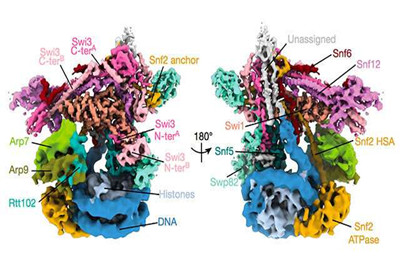
It is important to develop chemically selective scavengers for ions such as Ba2+, Ni2+, and Co2+ from complex wastewater for environmental remediation and human health. The current natural and synthetic absorbent materials, however, share the problems of low capacity and poor selectivity. In particular, the selective removal and separation of radionuclides from industrial nuclear wastes with high salt concentrations is a challenge.
In a recent study published in Chemistry of Materials., Prof. FENG Meiling from Fujian Institute of Research on the Structure of Matter of the Chinese Academy of Sciences, cooperating with Prof. Mercouri G. Kanatzidis from Northwestern University, U.S., reported the efficient and selective capture of Ba2+, Ni2+, and Co2+ with an acid- and radiation-resistant layered metal sulfide [Me2NH2]4/3[Me3NH]2/3Sn3S7·1.25H2O (FJSM-SnS).
133Ba, as one of the byproducts of nuclear fuel fissions, emits γ ray at the energy of 356 keV. Ba2+ is also employed as the simulant for highly radiotoxic 226Ra2+ because of their comparable ionic radii and similar adsorption behaviors. 60Co isotope and 63Ni emit strong γ and pure β radiation, respectively, both of them can be derived from neutron activation of reactor materials. Non-radioactive barium, nickel and cobalt ions are harmful to the ecosystem and human health.
The advantages of FJSM-SnS include rapid kinetics, strong exchange capacity, high selectivity and recovery rates, excellent acid and alkali resistance and efficient elution.
FJSM-SnS exhibits a faster adsorption ability with short equilibrium times, which is within five minutes. It has high adsorption capacity (289 mg/g for Ba, 83 mg/g for Ni, 52 mg/g for Co). It shows extremely high selectivity for Ba2+ even in the presence of excess Na+, K+, Cs+, Ca2+, Mg2+ and Sr2+. It also presents outstanding selectivities for Ni2+ and Co2+ (KdNi = 8.92 × 104 mL/g; KdCo = 3.75 × 105 mL/g) which surpass most of the reported ones.
Besides, FJSM-SnS retains its robust framework in wide pH range of 0.6-12.7.
Moreover, the captured barium, nickel, and cobalt in the exchanged products can be easily recovered by eluting them with 0.5 M KCl solution which highlights the recycling of resource. The recovery rates can be maintained 99.74, 99.30, and 99.65% of Ba2+, Ni2+, and Co2+ after processing 1100 bed volumes in low concentration (Ba2+, Ni2+, and Co2+: 704.9 ~ 928.6 μg/L), respectively.
These advantages, combined with the easy synthesis and excellent resistances β and γ irradiation make FJSM-SnS promising candidate as the radioactive Ba2+, Ni2+, and Co2+ ion-exchanger from nuclear waste solutions.
This study underscores the enormous potential of metal sulfides as new and low-cost materials for highly efficient and highly selective uptake of 133Ba, 63Ni, and 60Co and their nonradioactive isotopes, as well as 226Ra from complex wastewater.

